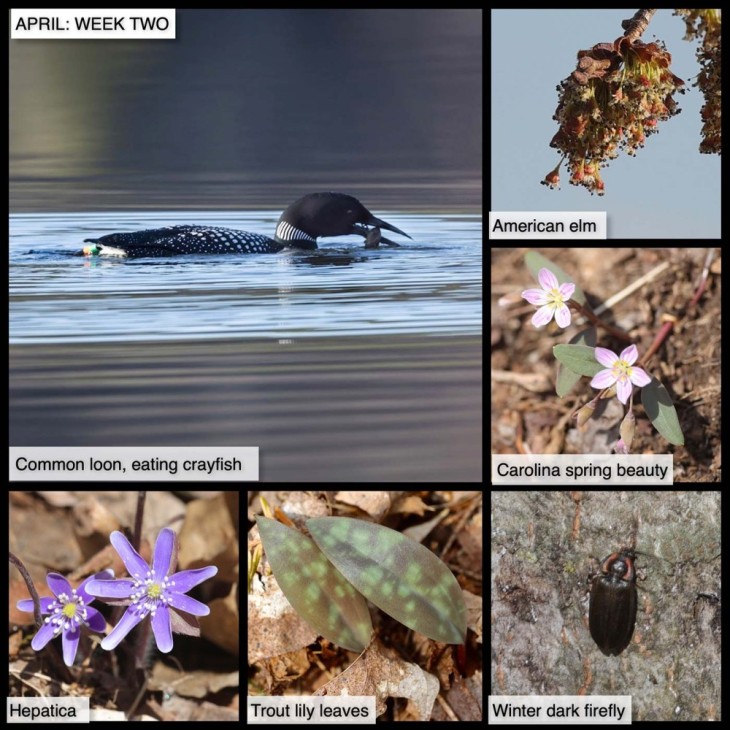This Week in the Woods, we are happy to see that common loons are returning from their coastal winter habitat. At the time the photo was taken, the loon had just resurfaced from under the lake with a crayfish in its bill. As noted by Tiffany Soukup in this Outside Story essay, loons are well designed for underwater hunting: their bones are denser and therefore less buoyant, and their legs are positioned far back on the body – a trait that “makes them excellent divers, allowing their legs to extend laterally like oars when kicking down.” Note also that the loon is wearing some shiny green hardware – it turns out that Eric Hanson banded this bird in 2013 on Lake Fairlee. Eric is the loon biologist for the Vermont Loon Conservation Project, a successful long-term partnership between the Vermont Center for Ecostudies and the Vermont Fish and Wildlife Department, supported by many dedicated volunteers. The Loon Preservation Committee is also involved in this project, and is responsible for rescuing many birds harmed by fishing lines and other hazards every year. You can read an interview with Eric here, which we published in anticipation of him speaking at the 2016 Northern Woodlands Conference. To see more images of common loons and listen to their famous yodeling calls, check out this profile from Cornell Lab’s All About Birds. And thanks to Tig Tillinghast for sharing the photo.
Here are some other nature sights this week (clockwise):
American elms are blooming. Their tiny, delicate flowers hang in clusters along the stems. As noted in this paper from the U.S. Forest Service, discussing the trees’ ecological role in floodplain forests, elms are primarily wind-pollinated, although bees will also visit them.
Spring beauties, some of the earliest-appearing ephemeral wildflowers, have started blooming. There are two species: Carolina spring beauty (pictured) and Virginia spring beauty. Here’s a profile of Carolina spring beauty from the Native Plant Trust (click on the link in the left column to see its cousin), and here’s an early Outside Story essay from Ned Swanberg, describing spring ephemerals’ fleeting lifestyle and explaining how past widespread clearing for pasture has reduced their presence in the woods.
Winter dark fireflies are flying from tree to tree and climbing somewhat clumsily up trunks. As Laurie Morrissey notes in this Outside Story essay, the beetles – lanternless members of the firefly clan – can often be found in the grooves of tree bark, and they’re mating now through May.
Suddenly, trout lilies are popping up everywhere. We won’t see their yellow flowers for a few weeks yet – typically in early May – but their dappled leaves are pretty in their own right. A commonly cited explanation for trout lily’s name is that the leaves’ markings resemble the speckles on brook trout.
Hepatica is blooming in abundance now, with exquisite flowers that range in color from white to pink to intense blue-violet, as shown here. As noted in a post from last month, there are two species growing in our region, sharp-lobed and round-lobed hepatica. As their names indicate, they are most easily distinguished by leaf shape.
Our thanks to The Bailey Charitable Foundation and the Frank and Brinna Sands Foundation for helping to support this series.
In this difficult period, many of us find joy in observing local nature. This series, launched in April 2020, shares nature photographs taken in the past seven days, or in the same week in 2020, most within 15 miles of the Northern Woodlands office in Lyme, New Hampshire. We hope you enjoy using this grid as a prompt for your own explorations.
What are you seeing in the woods this week? Share your images with us on Facebook, or submit a special photo for possible inclusion in our monthly online Reader Photo Gallery.


